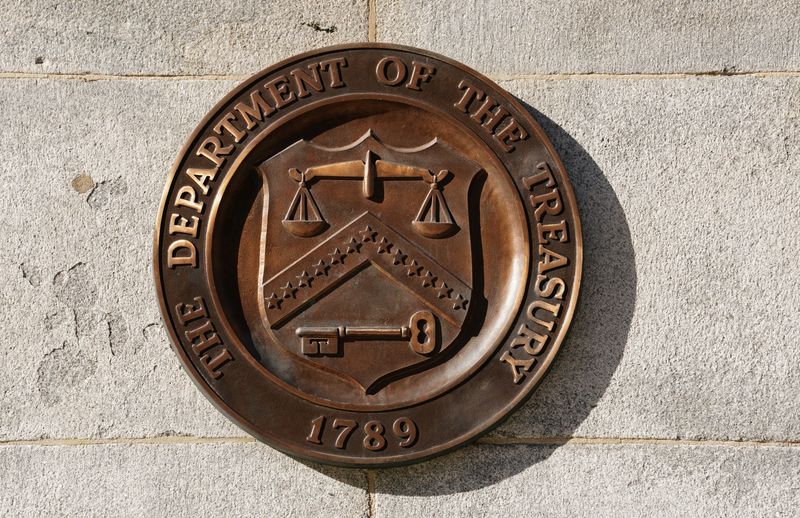Economy
Fed economists sound alarm on hedge funds gaming US Treasuries


© Reuters. FILE PHOTO: A bronze seal for the Department of the Treasury is shown at the U.S. Treasury building in Washington, U.S., January 20, 2023. REUTERS/Kevin Lamarque/File Photo
By Davide Barbuscia
NEW YORK (Reuters) – Researchers at the Federal Reserve have issued warnings in recent weeks about possible disruptions in U.S. Treasuries due to the return of a popular hedge fund trading strategy that exacerbated a crash in the world’s biggest bond market in 2020.
Hedge funds’ short positions in some Treasuries futures – contracts for the purchase and sale of bonds for future delivery – have recently hit record highs as part of so-called basis trades, which take advantage of the premium of futures contracts over the price of the underlying bonds, analysts have said.
The trades – typically the domain of macro hedge funds with relative value strategies – consist of selling a futures contract, buying Treasuries deliverable into that contract with repurchase agreement (repo) funding, and delivering them at contract expiry.
In two separate notes in recent weeks, economists at the Fed have highlighted potential financial vulnerability risks related to these trades, which are taking place at a time of volatility in the U.S. government bond market due to higher interest rates and uncertainty over future monetary policy actions.
“Cash-futures basis positions could again be exposed to stress during broader market corrections,” Fed economists said in an Aug. 30 note. “With these risks in mind, the trade warrants continued and diligent monitoring.”
Separately, in a Sept. 8 note that looked among other things at hedge funds’ Treasury exposures, Fed economists said there was a risk of a rapid unwind of basis trade positions in case of higher repo funding costs.
This would exacerbate episodes of market stress, they warned, “potentially contributing to increased Treasury market volatility and amplifying dislocations in the Treasury, futures, and repo markets.”
Commodity Futures Trading Commission (CFTC) data showed leveraged funds’ net shorts on some Treasuries futures were at near record highs in recent weeks, matched by large asset managers’ long positions – an indication of basis trades.
“The Fed is unlikely to view this accumulation of basis positions under too favorable a light and may eventually want to clamp down on them,” said Steven Zeng, U.S. rates strategist at Deutsche Bank. “However, the approach they take may not be straightforward as the Fed does not have direct regulatory oversight over hedge funds,” he said.
The Fed declined to comment on possible policy actions.
LIQUIDITY CONCERNS
The unwinding of basis trades contributed to illiquidity in Treasuries in March 2020, when the market seized up amid rising fears about the coronavirus pandemic, prompting the U.S. central bank to buy $1.6 trillion of government bonds.
Some market players fear a repeat of a similar situation may still be in the cards.
“Cash futures basis trades are vulnerable to two risks: higher margin costs on the futures short and higher financing costs on the cash long position,” Barclays said in a note on Tuesday.
Should financing costs increase in the repo market – where hedge funds obtain short-term loans against Treasury and other securities – the spread, or premium, of futures contracts over underlying cash Treasuries would also need to increase to maintain basis trade positions profitable.
Conversely, a sudden deterioration in the economy and a rapid drop in interest rates could push futures higher, triggering limits on maximum losses and forcing basis trade exits.
“This could potentially bring about a repeat of the March 2020 market turmoil and it is something that the Fed is keen to prevent,” Deutsche’s Zeng said.
Economy
Russian central bank says it needs months to make sure CPI falling before rate cuts -RBC


© Reuters. Russian Central Bank Governor Elvira Nabiullina attends a news conference in Moscow, Russia June 14, 2019. REUTERS/Shamil Zhumatov/File Photo
MOSCOW (Reuters) – Russia’s central bank will need two to three months to make sure that inflation is steadily declining before taking any decision on interest rate cuts, the bank’s governor Elvira Nabiullina told RBC media on Sunday.
The central bank raised its key interest rate by 100 basis points to 16% earlier in December, hiking for the fifth consecutive meeting in response to stubborn inflation, and suggested that its tightening cycle was nearly over.
Nabiullina said it was not yet clear when exactly the regulator would start cutting rates, however.
“We really need to make sure that inflation is steadily decreasing, that these are not one-off factors that can affect the rate of price growth in a particular month,” she said.
Nabiullina said the bank was taking into account a wide range of indicators but primarily those that “characterize the stability of inflation”.
“This will take two or three months or more – it depends on how much the wide range of indicators that characterize sustainable inflation declines,” she said.
The bank will next convene to set its benchmark rate on Feb. 16.
The governor also said the bank should have started monetary policy tightening earlier than in July, when it embarked on the rate-hiking cycle.
Economy
China identifies second set of projects in $140 billion spending plan


© Reuters. FILE PHOTO: Workers walk past an under-construction area with completed office towers in the background, in Shenzhen’s Qianhai new district, Guangdong province, China August 25, 2023. REUTERS/David Kirton/File Photo
SHANGHAI (Reuters) – China’s top planning body said on Saturday it had identified a second batch of public investment projects, including flood control and disaster relief programmes, under a bond issuance and investment plan announced in October to boost the economy.
With the latest tranche, China has now earmarked more than 800 billion yuan of its 1 trillion yuan ($140 billion) in additional government bond issuance in the fourth quarter, as it focuses on fiscal steps to shore up the flagging economy.
The National Development and Reform Commission (NDRC) said in a statement on Saturday it had identified 9,600 projects with planned investment of more than 560 billion yuan.
China’s economy, the world’s second largest, is struggling to regain its footing post-COVID-19 as policymakers grapple with tepid consumer demand, weak exports, falling foreign investment and a deepening real estate crisis.
The 1 trillion yuan in additional bond issuance will widen China’s 2023 budget deficit ratio to around 3.8 percent from 3 percent, the state-run Xinhua news agency has said.
“Construction of the projects will improve China’s flood control system, emergency response mechanism and disaster relief capabilities, and better protect people’s lives and property, so it is very significant,” the NDRC said.
The agency said it will coordinate with other government bodies to make sure that funds are allocated speedily for investment and that high standards of quality are maintained in project construction.
($1 = 7.1315 renminbi)
Economy
Russian central bank says it needs months to make sure CPI falling before rate cuts -RBC


© Reuters. Russian Central Bank Governor Elvira Nabiullina attends a news conference in Moscow, Russia June 14, 2019. REUTERS/Shamil Zhumatov/File Photo
MOSCOW (Reuters) – Russia’s central bank will need two to three months to make sure that inflation is steadily declining before taking any decision on interest rate cuts, the bank’s governor Elvira Nabiullina told RBC media on Sunday.
The central bank raised its key interest rate by 100 basis points to 16% earlier in December, hiking for the fifth consecutive meeting in response to stubborn inflation, and suggested that its tightening cycle was nearly over.
Nabiullina said it was not yet clear when exactly the regulator would start cutting rates, however.
“We really need to make sure that inflation is steadily decreasing, that these are not one-off factors that can affect the rate of price growth in a particular month,” she said.
Nabiullina said the bank was taking into account a wide range of indicators but primarily those that “characterize the stability of inflation”.
“This will take two or three months or more – it depends on how much the wide range of indicators that characterize sustainable inflation declines,” she said.
The bank will next convene to set its benchmark rate on Feb. 16.
The governor also said the bank should have started monetary policy tightening earlier than in July, when it embarked on the rate-hiking cycle.

 Forex3 years ago
Forex3 years agoForex Today: the dollar is gaining strength amid gloomy sentiment at the start of the Fed’s week

 Forex3 years ago
Forex3 years agoUnbiased review of Pocket Option broker

 Forex3 years ago
Forex3 years agoDollar to pound sterling exchange rate today: Pound plummeted to its lowest since 1985

 Forex3 years ago
Forex3 years agoHow is the Australian dollar doing today?

 Cryptocurrency3 years ago
Cryptocurrency3 years agoWhat happened in the crypto market – current events today

 World3 years ago
World3 years agoWhy are modern video games an art form?

 Commodities3 years ago
Commodities3 years agoCopper continues to fall in price on expectations of lower demand in China

 Economy3 years ago
Economy3 years agoCrude oil tankers double in price due to EU anti-Russian sanctions

























